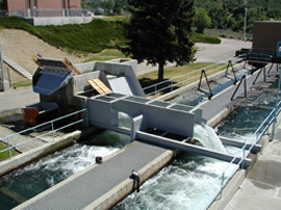|
|
|
||||
|
|
Conservation Measure Saves Stored Water in Deer Creek Reservoir Metropolitan Water District of Salt Lake & Sandy taps flood flows from Little Cottonwood Creek. June 11, 2002
During March 2002, the Metropolitan Water District of Salt Lake & Sandy (MWDSLS) took action to deal with almost certain water shortages this summer. The state of Utah was in the fourth year of a drought and projected runoff flows were estimated at 65 percent of normal. Water was going to be in short supply. The projected run-off into the Provo River Project (PRP) was not enough to improve the storage volume in Deer Creek Reservoir, which was at an all-time low. In March, Provo River Water Users Association general manager, G. Keith Denos, alerted the Association’s shareholders that Board of Directors had made a 60 percent allotment restriction until further notice. On April 24, the governor declared a statewide water emergency and an agricultural disaster. Deer Creek Reservoir is a critical water supply for Salt Lake City and Sandy City. Water managers were hoping that the water storage in the reservoir would improve over last year, however, in early spring the volume of PRP water stored in the reservoir was at its lowest point since 1949. Snowpack measurements indicated that the runoff would not improve the situation. MWDSLS’s Little Cottonwood Water Treatment Plant is supplied from two sources: its water in Deer Creek Reservoir and Little Cottonwood Creek. The two cities own the water rights in the creek. Under normal conditions, water is taken from the Murray Power Plant located on the southeast corner of the treatment plant. The quantity of water that can be delivered to the water treatment plant is controlled by the capacity of the pipeline connecting the power plant to the water treatment plant. One bright spot in the entire state of Utah was the Little Cottonwood Canyon watershed. The winter storms were such that the high peaks captured copious amounts of snow. During March the snowpack at the 9,620 elevation was normal with about 35 inches of equivalent water. This rose to 50 inches by May, a whopping 140 percent of normal . With no storage facility, most of this water would flow to the Jordan River. In an effort to tap this abundant supply and save as much stored water in Deer Creek Reservoir as possible, the MWDSLS staff recommended that a temporary connection, costing approximately $250,000, be constructed between the power plant and the water treatment plant. The additional 50 million gallons per day flow capacity would allow the district to capture more of the direct flows of Little Cottonwood Creek, enabling the district to conserve water in Deer Creek Reservoir. On February 25, MWDSLS general manger John Carman brough the project to the district’s Board of Trustees for their consideration. The trustees recognized the need and funding for the project as a high priority item and unanimously approved it. The engineering firm of Thompson-Hysell was hired to design/build the project to temporarily expand capacity of the Little Cottonwood creek supply. Absolute Constructors was subcontracted to construct the project. Completed during May at a cost of $203,000, the new conveyance and screening system was made ready for operation. During late May and early June, the value of the new connection became apparent. As the water demand increased, water that would have otherwise been drawn from Deer Creek Reservoir, stayed in the reservoir and was replaced with flood flows from the creek. Last year the Little Cottonwood Creek diversion produced about 45 million gallons per day -- this year it is over 100 million gallons per day. As of June 8 over 1,800 acre-feet of additional water supply at a replacement value of $360,000 was diverted and treated in the water treatment plant, more than paying for the project. It appears that there will be enough flow in Little Cottonwood Creek to sustain these flows for the remainder of June, increasing the pay back of the project. The temporary connection is a major conservation project, increasing the water supply during this water-short year. “In a drought year like this, it certainly makes sense to maximize the use of the resources that we have and I feel that this project accomplished this objective.” says Carman. The temporary connection will provide an added benefit during the upcoming plant reconstruction project when the primary power plant pipeline will be disconnected as part of the construction program. The connection will be used to keep the water treatment plant in service during this period. The 2002 drought will continue to be a challenge for water suppliers and the public during the coming year. The water saved by the Little Cottonwood temporary intake structure will contribute to meeting the summer water supply needs.
|
